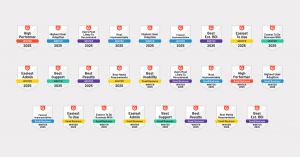Architecture is deeply personal, especially in the residential space. Clients aren’t just investing in a structure, they’re trusting someone to shape their home, their lifestyle, and often their life savings.
So how do you create a design experience that feels both elevated and approachable?
We spoke with Emma Holmes, Registered Architect, Founder & Director of Formery Architecture + Interiors, and member of the Blueprint Collective, about how she’s building a more human, transparent process for residential architecture.
With experience across tier one studios, high-end homes, and in-house development teams, Emma shared how her practice is redefining quality, guiding clients through budget decisions, and using builder relationships to strengthen every outcome.
Keep reading to hear Emma’s take.
What does “high quality” mean to your clients, and how do you help define it?
EH: Quality means different things to different people. For some, it’s about materiality. For others, it’s about longevity, choosing finishes that hold up over time and require less maintenance. Another layer to this discussion is the quality of documentation. My job is to translate what clients are asking for into drawings that are clear, detailed, and buildable.
I always aim to show clients relevant examples and guide them through the decision making process so they understand what they’re getting and why it matters. When something is going to cost more, there should be a clear reason behind it, and that reason should be meaningful to the client.
How do you manage expectations when clients want it all on a limited budget?
EH: That’s the Pinterest problem. Client’s often bring in beautiful reference images without understanding that many of them are from multi-million dollar builds. I see my role as helping clients unpack those images. What specifically do you love about this? Is it the light, the material, the mood? And how can we weave that into their brief.
From there, I offer alternatives that keep the look and feel they want, without blowing the budget. Maybe it’s suggesting the use of porcelain instead of natural stone. Maybe it’s repetitive detailing instead of expensive custom designs. It’s like putting together an outfit. You don’t need a head-to-toe designer to look great. It’s about knowing where to spend and where to save to get maximum value for money.
What’s one early decision that has the biggest downstream impact on cost?
EH: Early contractor involvement. Bringing in a builder and obtaining a cost estimate during the concept design phase gives us a clear picture of the overall cost before we move too far down the track. This helps us proactively value manage at the beginning instead of cutting things out at the end.
It also creates a feedback loop. Builders can tell us which materials work well, what’s currently hard to source, or what brands they prefer and why. That additional layer of input makes my drawings better and the final outcome stronger.
Do clients sometimes underbudget for the things they care most about?
EH: Definitely. Joinery is a big one. Everyone wants good storage, but custom joinery (built-in elements like wardrobes, shelving, and cabinetry) can be surprisingly expensive. And clients don’t always expect that.
It’s my responsibility to flag that early. If a client wants to add more storage, I’ll let them know how that impacts the overall cost and help them decide if it’s worth it. In some cases, we’ll stage the work. Focus on what’s essential now, and leave room to add on later. That way, they don’t overextend themselves and still get a home that works for them.
What advice would you give younger architects about balancing creativity with financial responsibility?
EH: Architecture isn’t a race. There’s value in slowing down, researching, and revising. Every site has its own set of constraints. Those constraints can lead to stronger, more thoughtful design.
Not every project will be your dream project. Some are more functional. Some are more client-led. But they all teach you something. Protect your passion, be honest about budget limitations, and stay committed to good outcomes. That mindset will carry you far.
Final Thoughts
For Emma Holmes, great design is about more than aesthetics. It’s about guiding clients with care, being honest about what’s possible, and creating spaces that feel just as good to live in as they look on paper. Whether it’s managing expectations, collaborating with builders, or translating high-end ideas into achievable outcomes, her approach puts people first at every step.
About Formery Architecture + Interiors
Formery is a Melbourne-based architecture and interiors studio focused on creating intentional, high-quality residential design. From custom homes to multi-residential developments, Formery helps clients navigate the complexity of building with clarity and confidence. The studio combines thoughtful design with modern systems to make the process as seamless and collaborative as possible.
About Emma Holmes
Emma Holmes is the founder and principal architect of Formery. With experience across tier one studios, boutique firms, and in-house development teams, Emma brings a holistic understanding of the entire project journey. She is passionate about simplifying the process for clients and believes that great design starts with empathy, honesty, and strong communication.
Featured Projects
Bentleigh East: Townhouse Development

Emma helped guide a first-time developer through land subdivision, site strategy, and budget allocation. They fought for design choices like gable roofs and thoughtful street orientation, challenging council expectations to create something that stood out from the standard volume-built townhouses in the area.
Mordialloc: Private Residence 

This family almost went with a drafts person, unsure if an architect was worth the investment. Working with Formery showed them the value of a more integrated, detail-driven approach. From facade materials to kitchen fixtures, Emma stayed hands-on from concept to completion. The result? A home that matched the drawings exactly, and a client who couldn’t be happier.
The Blueprint Collective: A Community for A&E Innovators
Emma and this article are part of the Blueprint Collective, a free, members-only content program that highlights top architecture and engineering firms. We do all the work, you get all the credit.
Each month, we interview you for 30 minutes, then write, design, and promote custom content about your firm. You’ll get beautifully branded materials, backlinks, and social promotion, all with full approval rights. It’s free PR, real thought leadership, and zero lift on your part. Learn how to join the Blueprint Collective here.




